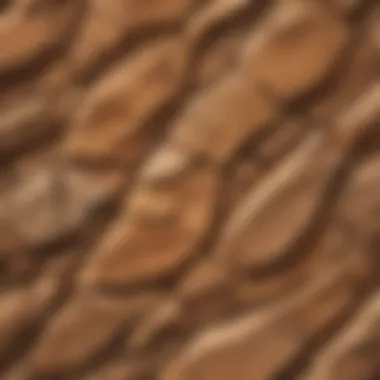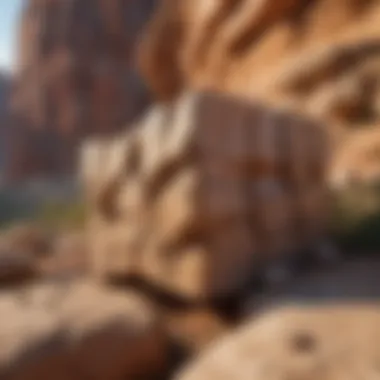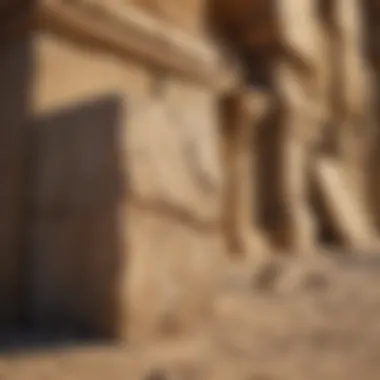Unveiling the Mesmerizing World of Sandstone Blocks in Geological Collections


Rock and Fossil Identification-
In the realm of geological collections, the identification of sandstone blocks holds a significant place. Sandstone is a sedimentary rock known for its unique composition of sand-sized minerals and rock grains held together by a mineral cement. It exhibits a wide range of colors and patterns, making it a visually striking specimen for collectors. When identifying sandstone blocks, keen collectors must look for key characteristics such as varying grain sizes, sedimentary structures, and distinctive mineral formations embedded in the rock matrix. Utilizing tools such as magnifying glasses, hardness picks, and UV lights can aid in the identification process, enhancing the collector's ability to discern the subtle features that differentiate one sandstone block from another.
Introduction
Sandstone blocks hold a mesmerizing allure within geological collections, serving as intricate pieces that narrate tales of Earth's history. This article delves deep into the intricate world of sandstone blocks, shedding light on their formation processes, rare varieties, and their profound significance in geological collections. By unraveling the mysteries of these geological marvels, this article aims to provide enthusiasts, particularly rock and fossil collectors, with a comprehensive guide to understand, appreciate, and collect these unique specimens.
Understanding Sandstone Blocks
Composition and Characteristics
Sandstone blocks are defined by their composition and unique characteristics, forming through the accumulation of sand grains cemented together over time. The distinctive feature of sandstone lies in its composition, primarily composed of quartz and feldspar minerals. This composition imparts durability and aesthetic appeal, making sandstone blocks a popular choice for geological collections. The varying proportions of minerals result in an array of colors and textures, adding to their collectible properties. However, the porosity of sandstone can be a double-edged sword, as it can absorb water and weather over time, affecting its preservation.
Formation Process
The formation process of sandstone blocks involves the gradual compaction and cementation of sand grains under immense pressure over millions of years. This slow process ensures the consolidation of grains into solid rock, creating the distinct layers and sediments seen in sandstone formations. The key characteristic of this process is the preservation of sedimentary structures, offering insights into ancient environments and geological conditions. While the formation process results in the unique beauty of sandstone blocks, it also contributes to their fragility and susceptibility to erosion, emphasizing the importance of proper preservation techniques.
Significance in Geological Collections
Rare Varieties
Rare varieties of sandstone blocks encompass distinctive compositions, colors, and patterns that are seldom found in geological formations. These unique specimens attract collectors due to their scarcity and aesthetic appeal, adding a layer of exclusivity to geological collections. The rareness of these sandstone blocks elevates their collectible value, making them prized possessions among enthusiasts. However, the rarity of these specimens also poses challenges in acquisition and preservation, requiring meticulous care to ensure their longevity.
Collectible Properties
The collectible properties of sandstone blocks stem from their unique characteristics, such as color variations, sedimentary structures, and mineral inclusions. These properties not only enhance the visual appeal of the specimens but also offer valuable insights into the geological history embedded within each block. Collectors are drawn to the captivating stories that sandstone blocks tell through their distinct properties, making them sought-after additions to geological collections. Despite their value as collectibles, preserving these properties necessitates specialized techniques to maintain their authenticity and aesthetic appeal.
Relation to Geological History


Eras and Periods
Sandstone blocks serve as historical markers, reflecting the geological eras and periods in which they were formed. Each layer of sandstone represents a specific time in Earth's history, capturing the environmental conditions and sedimentary processes prevalent during that era. By studying the eras and periods represented in sandstone blocks, geologists and collectors can reconstruct past landscapes and climates, unraveling the interconnected story of Earth's evolution. The distinct characteristics of sandstone layers offer a tangible link to the past, providing a tangible glimpse into the geological timeline.
Geological Significance
The geological significance of sandstone blocks lies in their role as archives of Earth's past, preserving a wealth of information within their layers. These blocks contain vital clues about ancient ecosystems, climate patterns, and geological events, offering a window into the planet's history. By examining the geological significance of sandstone blocks, researchers can decipher complex geological processes, contributing to a deeper understanding of Earth's evolution. Despite their importance in unraveling geological mysteries, these blocks require careful handling and conservation to safeguard their invaluable insights for future generations.
Exploring Sandstone Blocks
Popular Sandstone Block Formations
Layers and Sediments
Within the realm of sandstone block formations, the aspect of layers and sediments plays a crucial role in determining the essence and quality of the blocks. Layers and sediments contribute significantly to the overall composition and visual appeal of these geological specimens. The distinct stratification present in sandstone layers provides invaluable insight into the environmental conditions during their formation, offering a glimpse into the ancient past encapsulated within each block. The textural diversity and color variations within these layers make them a sought-after choice for collectors and researchers seeking to unravel the geological narratives etched in stone. Despite their intricate beauty, layers and sediments may present challenges in preservation due to their susceptibility to erosion and weathering over time. Thus, while layers and sediments enhance the aesthetic allure of sandstone blocks, they also demand meticulous care to maintain their integrity and historical relevance.
Colors and Textures
Another captivating aspect of sandstone blocks is the interplay of colors and textures that define their visual appeal and scientific significance. Colors ranging from earthy browns to vibrant reds infuse these formations with a spectrum of hues that reflect the mineral content and environmental conditions responsible for their genesis. The unique textures found in sandstone blocks add a tactile dimension to their allure, inviting admirers to explore the intricate patterns formed through geological processes. This variability in colors and textures not only enhances the aesthetic appeal of sandstone blocks but also provides vital clues about their formation and mineral composition. However, the conservation of these vibrant colors and delicate textures poses a challenge for collectors and curators, necessitating careful handling and preservation techniques to prevent deterioration and maintain the integrity of these geological treasures.
Geological Sites of Interest
World-renowned Locations
When delving into the exploration of sandstone blocks, the focus on world-renowned geological sites of interest opens doors to a wealth of knowledge and discovery. These renowned locations serve as epicenters of geological diversity, showcasing a myriad of sandstone formations that have attracted attention from researchers and enthusiasts worldwide. Their strategic geological significance and exceptional beauty make them prime destinations for those seeking to witness firsthand the wonders of nature preserved in stone. By studying the formations at these sites, researchers can gain valuable insights into the geological processes at play and unravel the layered history embedded within each block. However, the popularity of these locations also raises concerns about preservation and sustainable tourism, necessitating a balance between exploration and conservation to safeguard these geological treasures for future generations.
Uncommon Discoveries
In the realm of sandstone block exploration, the allure of uncommon discoveries holds a special fascination for collectors and researchers alike. These serendipitous findings offer unique insights into geological processes and unearth rare specimens that challenge existing knowledge and perceptions. Uncommon discoveries provide a glimpse into the unexplored depths of geological diversity, offering exciting opportunities for scientific inquiry and further exploration. The novelty and rarity of these discoveries elevate their value within geological collections, making them prized possessions for enthusiasts seeking to expand their knowledge and exhibit unique specimens. However, the procurement and preservation of these uncommon discoveries require meticulous planning and ethical considerations to ensure their longevity and contribution to the scientific community, underscoring the delicate balance between discovery and conservation in the realm of sandstone block exploration.


Collecting and Preserving Sandstone Blocks
In the realm of geological collections, the aspect of collecting and preserving sandstone blocks holds paramount significance, serving as a vital component in enhancing our understanding of Earth's history and geological evolution. The meticulous process of acquiring and safeguarding these geological marvels not only contributes to the expansion of scientific knowledge but also enriches the world of rock and fossil collectors.
Methods of Collection
Field Techniques
Field techniques play a pivotal role in the collection of sandstone blocks, as they involve meticulous strategies for extracting these geological specimens from their natural environments while ensuring minimal disturbance to their composition and structure. The utilization of specialized tools and methods tailored for fieldwork expeditions enhances the efficiency and accuracy of the collection process, enabling collectors and geologists to procure high-quality specimens for further analysis and study.
Field techniques are characterized by their emphasis on precision and attention to detail, with practitioners often honing their skills to adeptly recognize valuable sandstone formations amidst diverse geological settings. The hands-on approach adopted in field techniques not only facilitates the identification and retrieval of unique specimens but also fosters a deeper connection with the geological landscape, instilling a profound appreciation for the natural wonders preserved within sandstone blocks.
Ethical Practices
Ethical practices in the context of collecting and preserving sandstone blocks epitomize the ethical standards and considerations that guide collectors and researchers in their interactions with geological resources and environments. By upholding ethical principles such as sustainability, respect for land rights, and adherence to conservation laws, practitioners ensure that their actions contribute positively to the sustainable preservation of geological specimens and ecosystems.
Key characteristics of ethical practices include a commitment to minimizing ecological impact, engaging in collaborative partnerships with local communities, and advocating for responsible stewardship of geological resources. Through ethical practices, collectors and researchers bolster the integrity of geological collections and promote a culture of environmental consciousness within the scientific community.
Preservation Techniques
Cleansing and Storage
The preservation of sandstone blocks encompasses a range of techniques, starting with the crucial processes of cleansing and storage. Cleansing involves the removal of impurities, debris, and contaminants from the surface of sandstone blocks, safeguarding their integrity and ensuring optimal visibility of geological features. Storage techniques are equally vital, as they involve the selection of suitable environments and materials for preserving sandstone blocks, mitigating factors that could lead to degradation or alteration of the specimens over time.
The key characteristic of cleansing and storage lies in their role as protective measures that extend the lifespan and visual appeal of sandstone blocks, enabling collectors and researchers to showcase these geological treasures with clarity and authenticity. By implementing effective cleansing and storage practices, individuals contribute to the longevity and cultural value of sandstone blocks within geological collections.
Preventing Deterioration
Preventing deterioration is a critical aspect of preserving sandstone blocks, as it entails proactive strategies aimed at mitigating factors that could compromise the structural integrity and aesthetic appeal of these geological specimens. By implementing measures such as climate control, UV protection, and proper handling protocols, collectors and institutions safeguard sandstone blocks from environmental threats and physical damage, ensuring their longevity and research value.


The key characteristic of preventing deterioration lies in its focus on proactive maintenance and risk mitigation, addressing potential sources of degradation before they can impact the quality and authenticity of sandstone blocks. Through meticulous attention to preservation techniques, collectors and researchers uphold the sanctity of geological collections and contribute to the continued study and appreciation of sandstone's unique attributes.
Showcasing Sandstone Blocks
In the realm of geological collections, the topic of showcasing sandstone blocks holds a pivotal role in this comprehensive article focused on Unveiling the Marvel of Sandstone Blocks. Inspecting and displaying these geological marvels offer enthusiasts a gateway to a deeper understanding of the Earth's history and composition, making it a fundamental subject matter in the narrative. Through showcasing sandstone blocks, collectors and researchers can elucidate the intricate details embedded within each block, shedding light on their unique characteristics and formation processes, enriching the overall experience of interacting with geological artifacts.
Exhibitions and Collections
Display Strategies
Delving into the intricate world of Display Strategies within the context of sandstone block exhibitions unveils a treasure trove of methodical approaches to captivate audiences. The manner in which these geological specimens are presented plays a crucial role in engaging viewers and conveying the nuances of each block's composition and significance. Display Strategies encompass a spectrum of techniques ranging from lighting arrangements to spatial organization, all aimed at maximizing the visual impact and educational value of the showcased blocks.
One key characteristic that distinguishes Display Strategies is their ability to transform static geological displays into dynamic, visually appealing showcases. By strategically positioning sandstone blocks within an exhibition space, curators can accentuate the intricate details, colors, and textures of each specimen, allowing visitors to appreciate the geological diversity preserved within these blocks. This interactive approach not only enhances the aesthetic appeal of the exhibition but also fosters a deeper connection between the audience and the geological wonders on display.
The unique feature of Display Strategies lies in their adaptability to cater to diverse audiences, from seasoned collectors to curious beginners. By tailoring the presentation style to suit the preferences and knowledge levels of visitors, exhibitions can effectively educate and inspire individuals of varying interests and expertise in the field of geology. However, a potential disadvantage of elaborate Display Strategies may lie in overshadowing the intrinsic beauty of the sandstone blocks with excessive embellishments, risking a loss of focus on the geological significance that underpins each exhibit.
Interactive Exhibits
The incorporation of Interactive Exhibits within sandstone block showcases revolutionizes the traditional museum experience by fostering immersive and participatory engagement among visitors. Interactive Exhibits serve as dynamic platforms that enable audiences to not only observe but also interact with geological specimens, offering a multi-sensory exploration of the world of sandstone blocks. By employing technology, tactile elements, and informative displays, Interactive Exhibits bridge the gap between theoretical knowledge and hands-on experience, making the geological journey accessible and captivating for audiences of all ages and backgrounds.
A key characteristic of Interactive Exhibits is their ability to democratize geological learning, breaking down complex subjects into digestible, engaging components that resonate with a wide range of visitors. Through interactive elements such as touch screens, virtual simulations, and tactile models, users can delve into the formation processes of sandstone blocks, explore their compositional intricacies, and unearth the geological narratives intertwined within each specimen. This hands-on approach not only enhances the educational value of the exhibition but also cultivates a sense of curiosity and discovery among participants, fostering a lasting interest in geology.
The unique feature of Interactive Exhibits lies in their potential to cater to different learning styles and preferences, making complex geological concepts accessible through engaging and interactive means. By encouraging active participation and exploration, these exhibits create memorable and impactful experiences that resonate with visitors long after they've left the exhibition hall. However, a possible disadvantage of Interactive Exhibits could be the reliance on technology, which may limit accessibility for certain audience segments or detract from the authenticity of the geological artifacts on display.
Conclusion
In the grand tapestry of geological collections, the significance of sandstone blocks cannot be understated. As we conclude this exploration into the marvels of sandstone, it becomes evident that these natural wonders serve as invaluable pieces of Earth's history and artistry. The beauty and importance of sandstone blocks lie not only in their aesthetic appeal but also in the compelling stories they tell about our planet's past. Through the meticulous curation and display of these blocks, researchers, collectors, and enthusiasts alike are offered a glimpse into the intricate workings of time and geology, enriching our understanding of the world around us.
Appreciating Sandstone Blocks
Beauty in Nature
Delving into the essence of sandstone blocks, one cannot overlook the unparalleled beauty they exude. The intricate interplay of colors, textures, and formations within these blocks unveils a masterpiece crafted by nature itself. The allure of sandstone lies in its ability to captivate the eye with a kaleidoscope of hues, from earthy reds to serene yellows, each layer narrating a chapter of geologic history. This natural artwork serves as a testament to the creative forces at work over millennia, enticing collectors and enthusiasts with its timeless elegance. While the beauty of sandstone blocks is undeniable, their aesthetic appeal goes beyond mere visual pleasure, transcending into a realm of artistic and geological fusion that resonates with all who appreciate the wonders of the natural world.
Intriguing Geological Narratives
Embedded within the intricate patterns of sandstone blocks are intriguing geological narratives waiting to be deciphered. Each layer, each sedimentary inclusion, unravels a story of ancient landscapes, climatic shifts, and geological processes that have sculpted these formations through ages. The subtle variations in composition, the faint traces of fossils, and the subtle crystal formations all contribute to a rich tapestry of Earth's past, showcasing the dynamic history of our planet. Unraveling these narratives not only provides invaluable insights into geological phenomena but also offers a glimpse into the interconnectedness of Earth's past, present, and future. The lure of these geological narratives lies in their ability to transport us back in time, connecting us with the geological heritage that shapes our world today.







